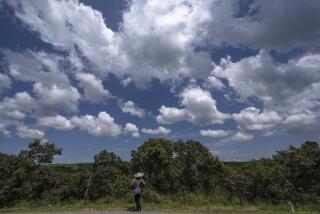Sri Lankan Aborigines Hang On as Tourist Attraction
- Share via
DAMBANA, Sri Lanka — The tribesman’s wild black hair and his wispy beard, specked with red tobacco juice, quivers as he crashes one jagged stone into another. An orange spark shoots up, smoke billows for a moment, then flames burst out.
Uru Warige Hudu Bandiya Atto, one of the last remaining Veddha aborigines of Sri Lanka, has done something his people have been doing since the Stone Age--making fire by bashing rocks together.
Then he looks up and says something his people certainly have not been saying since the Stone Age.
“For somebody else I’d charge 500 rupees. For you,” he says, pausing with the guile of a market haggler, “give me whatever you’re happy with.”
Stone Age Men Inc.
Here in the aboriginal village of Dambana, 85 miles east of the capital of Colombo, for a few dollars Veddhas will make fire from stones, dance a tribal jig, shoot a whistling arrow through the underbrush or pose for photos in loincloths, gazing stoically into the forest where they once thrived.
It’s a melancholy commercialization of the ancient culture of the Veddhas, the original inhabitants of this tropical island off India’s southern tip.
For thousands of years and through waves of invaders, they maintained their ways, living in the jungle, hunting wild boar, iguana and deer, worshiping forest gods.
But in recent years they have been pushed off their traditional lands, and the government has tried to “civilize” them. Then tourists began dropping by, offering rewards for each snap of a Nikon--if the Veddhas behaved like cavemen.
Bit by bit, most of the Veddhas have assimilated into the general population, and their numbers have dwindled from several thousand at the beginning of this century to just a few hundred in this nation of 18 million people.
Their traditions are in a strange spot, at once corrupted and kept alive by invaders in white tour buses.
Anthropologists say the Veddhas trace directly back to the prehistoric island people of 14,000 BC or earlier. Thought to be related to Australian aborigines, the Veddhas roamed freely until the 5th century BC, when Buddhists and then Hindus migrated from India.
The Veddhas had no system of land ownership recognized by the invaders, who gradually encroached upon their hills, rivers and forests.
However, the most dramatic changes have come in the last few decades. In the 1950s the government built a reservoir in the dry central lowlands where most of the Veddhas lived, inundating their hunting land and flooding their caves.
Then it formed a Veddha “welfare” committee that attempted to whittle away the ancient traditions and get the aborigines into suits and ties.
More such projects followed, and in 1983 the government declared that the Veddhas’ last large hunting forest would become a protected wildlife reserve. After tens of thousands of years, the Veddhas were made poachers on their own land.
“They would go into the forest and get honey and hunt, but it was illegal,” says Suranjan Koddithuwakku, an environmental activist in the Green Movement of Sri Lanka. “Many times they were taken into custody.”
Primal or Cynical?
The Veddhas were resettled in rehabilitation villages and told to become rice farmers. Successive governments have superficially recognized the Veddhas’ right to hunt but have failed to restore their land.
With the jungles lost to them, many Veddhas have become farmers and abandoned the old practices tied to the thick forests now surrounded by gates and guards.
A core group of Veddhas around the village of Dambana clings to some ancestral practices despite, or perhaps because, of the tourist trade.
Dulara Jayasinghe, a teacher from Kalutara, 25 miles south of Colombo, has brought a busload of friends and family to see the Veddhas in Dambana. His buddies pose for snapshots, grinning for the camera, their arms draped around the aborigines’ shoulders.
“Veddhas don’t like us coming to this place,” Jayasinghe says. “We shouldn’t bring our families . . . but people like it.”
Those Veddhas who count on tourist money know well what their customers want to hear: They say outsiders rarely visit, even as streams of tourists walk by. They claim to use bows and arrows to hunt, even though they have guns. And they say they’re little touched by the modern world, despite being wily enough to profit from it.
His black and silver hair pulled back tight, Uru Warige Kendala Atto sits in a flowery loincloth, spits betel nut juice into a deep bowl and reflects on the tourist influx.
“The life for our great-grandparents, it was much better than now,” he says. “There was no one coming to visit us and enough animals.”
Times are different, but he believes the Veddhas will never fade completely.
“Though the tiger may change his jungle, the tiger is still a tiger,” he says. “There will be at least one Veddha left until the end of the days.”
More to Read
Sign up for The Wild
We’ll help you find the best places to hike, bike and run, as well as the perfect silent spots for meditation and yoga.
You may occasionally receive promotional content from the Los Angeles Times.






